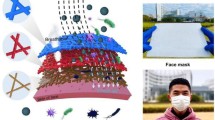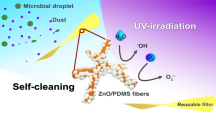Abstract
Disposable Surgical Face Masks (SFMs) are being used in the fight against Corona VIrus Disease-19 (COVID-19) during the pandemic. Since SFMs are made of polymers, their mass production causes severe environmental pollution. To reduce the SFM pollution, we have synthesized ash from the SFMs by incineration. A simple solution casting method is used to blend the surgical face mask ash (SFMA) with biodegradable hydroxypropyl methylcellulose polymer (HPMC). We have successfully adopted the Thermally Induced Phase Separation (TIPS) method to fabricate HPMC–SFMA films using water as the solvent. The successful incorporation of SFM-derived ash into the HPMC matrix was confirmed by FT-IR and FE-SEM characterization techniques. The addition of SFMA to the HPMC matrix has implications for Young’s modulus, as well as their biodegradation behavior. The incorporation of SFMA in the HPMC matrix changes its stiffness and elasticity, potentially affecting the film’s mechanical performance. Furthermore, while HPMC is biodegradable, the inclusion of SFMA hinders its biodegradation rate and enhances the life span of HPMC. Hence, the HPMC–SFMA films would be a promising candidate for agricultural mulching and this work leads to a conceptual basis for the production of novel materials in agricultural mulching.







Similar content being viewed by others
Availability of Data and Materials
Not applicable.
References
Meyerowitz EA, Richterman A, Gandhi RT, Paul E (2021) Transmission of SARS-CoV-2: a review of viral host and environmental factors. Ann Intern Med 174:69
Cifuentes-Faura J (2021) Analysis of containment measures and economic policies arising from COVID-19 in the European Union. Int Rev Appl Econ 35:242–255
Selvaranjan K, Satheeskumar N, Pathmanathan R, Nishanthan R (2021) Environmental challenges induced by extensive use of face masks during COVID-19: a review and potential solutions. Environ Chall 3:100039
Du H, Huang S, Wang J (2022) Environmental risks of polymer materials from disposable face masks linked to the COVID-19 pandemic. Total Environ Sci 815:152980
Oisik D, Rasoul EN, Antonio JC, Mikael S, Hedenqvist MF, Qiang X, Lin J, Dongxiao J, Seeram R (2020) The need for fully bio-based facemasks to counter coronavirus outbreaks: a perspective. Sci Total Environ 736:139611
Selvakumar D, Veeramuthu A, Rajesh P, Heli S, Kit W, Wei-Hsin C, Chawalit N (2021) Pyrolysis: an effective technique for degradation of COVID-19 medical wastes. Chemosphere 275:130092
Gatto A, Drago C, Ruggeri M (2022) On the frontline—a bibliometric study on sustainability development coronaviruses and COVID-19. Environ Sci Pollut Res 30:42983–42999
Gunasekaran K, Bilal M, Gabriel ED, Prabhu K, Mayakrishnan M, Rajeswari MV, Saravanakumar A (2023) Personal protective equipment (PPE) pollution driven by COVID-19 pandemic in Marina Beach, the longest urban beach in Asia: abundance, distribution, and analytical characterization. Mar Pollut Bull 186:114476
Ortega F, Calero M, Rico N, Martín-Lara MA (2023) COVID-19 personal protective equipment (PPE) contamination in coastal areas of Granada. Spain Mar Pollut Bull 191:114908
Cristina P, Miguel A, Emilio R, Marina P, Juan L (2021) Deposition of gum rosin microspheres on polypropylene microfibres used in face masks to enhance their hydrophobic behaviour. Environ Technol Innov 24:101812
Ana MO, Ana L, Amadeu MVM, Damià B, Armando CD, Teresa R (2023) Current knowledge on the presence biodegradation and toxicity of discarded face masks in the environment. J Environ Chem Eng 11:109308
Knicker H, Velasco-Molina M (2022) Biodegradability of disposable surgical face masks littered into soil systems during the COVID 19 pandemic—a first approach using microcosms. Soil Syst 6:39
Benson NU, Bassey DE, Palanisami T (2021) COVID pollution: impact of COVID-19 pandemic on global plastic waste footprint. Heliyon 7:06343
Saberian M, Li J, Kilmartin-Lynch S, Boroujeni M (2021) Repurposing of COVID-19 single-use face masks for pavements base/subbase. Sci Total Environ 769:145527
Ahmed W, Lim CW (2022) Effective recycling of disposable medical face masks for sustainable green concrete via a new fiber hybridization technique. Constr Build Mater 344:128245
Qu Y, Feng BL (2022) Straw mulching improved yield of field buckwheat (Fagopyrum) by increasing water-temperature use and soil carbon in rain-fed farmland. Acta Ecol Sin 42:11–16
Yang C, Gao X (2022) Impact of microplastics from polyethylene and biodegradable mulch films on rice (Oryza sativa L.). Sci Total Environ 828:154579
Saurabh S, Ramsha K, Abhishek S, Sekar S (2022) Microplastics from face masks: a potential hazard post Covid-19 pandemic. Chemosphere 302:134805
Heather A, Leslie MJM, van Velzen H, Brandsma A, Dick Vethaak JJ, Garcia V, Marja H (2022) Lamoree discovery and quantification of plastic particle pollution in human blood. Environ Int 163:107199
Wu F, Misra M, Mohanty AK (2021) Challenges and new opportunities on barrier performance of biodegradable polymers for sustainable packaging. Prog Polym Sci 117:10139
Sander M (2019) Biodegradation of polymeric mulch films in agricultural soils: concepts knowledge gaps and future research directions. Environ Sci Technol 53:2304
Wang Y, Jiang S, Chen Y, Qiu D, Weng Y (2023) Synthesis and characterization of a novel composite edible film based on hydroxypropyl methyl cellulose grafted with gelatin. Gels 9:332
Ding C, Zhang M, Li G (2015) Preparation and characterization of collagen/hydroxypropyl methylcellulose (HPMC) blend film. Carbohyd Polym 119:194–201
Imran M, Elfahmy S, Revoljunelles-Junelles AM, Desobry S (2010) Cellulose derivative based active coatings: effects of nisin and plasticizer on physico-chemical and antimicrobial properties of hydroxypropyl methylcellulose films. Carbohyd Polym 81:219–225
Klangmuang P, Sothornvit R (2019) Barrier properties, mechanical properties and antimicrobial activity of hydroxypropyl methylcellulose-based nanocomposite films incorporated with Thai essential oils. Food Hydrocoll 61:609–616
Aydogdu A, Yildiz E, Ayhan Z, Aydogdu Y, Sahin S (2019) Nanostructured poly(lactic acid)/soy protein/HPMC films by electrospinning for potential applications in food industry. Eur Polym J 112:477–486
Mansoor Z, Tchuenbou-Magaia F, Kowalczuk M, Adamus G, Manning G, Parati M, Radecka I, Khan H (2022) Polymers use as mulch films in agriculture—a review of history, problems and current trends. Polymers 14:5062
Prasad P, Guru GS, Shivakumar HR, Rai KS (2008) Miscibility thermal and mechanical studies of hydroxypropyl methylcellulose/pullulan blends. J Appl Polym Sci 110:444–452
Bilbao-Sáinz C, Avena-Bustillos RJ, Wood DF (2010) Composite edible films based on hydroxypropyl methylcellulose reinforced with microcrystalline cellulose nanoparticles. J Agric Food Chem 58:3753–3760
Samuel K, Joshua SB, Babur ZC, Milan D, Milan DA (2019) Glassy state molecular mobility and its relationship to the physico-mechanical properties of plasticized hydroxypropyl methylcellulose (HPMC) films. Int J Pharm X 1:100033
Wenlong L, Yang Z, Douxin X, Jingli C, Jinhao Z (2020) A biodegradable water-triggered chitosan/hydroxyl propyl methylcellulose pesticide mulch film for sustained control of Phytophthora sojae in soybean. J Clean Prod 245:118943
Yousef S, Justas E, Nerijus S, Mohammed AA (2021) Pyrolysis kinetic behavior and TG-FTIR-GC–MS analysis of Coronavirus Face Masks. J Anal Appl Pyrolysis 156:105118
Leonelli C, Turk K, Poggetto GD, Catauro M, Traven K, MaukoPranjić A, Ducman V (2022) Environmental and biological impact of fly ash and metakaolin-based alkali-activated foams obtained at 70 °C and Fired at 1000 °C. Front Chem 10:845452
Teodorescu GM, Vuluga Z, Oancea F, Ionita A, Paceagiu J, Ghiurea M, Nicolae CA, Gabor AR, Raditoiu V (2023) Properties of composites based on recycled polypropylene and silico-aluminous industrial waste. Polymers 15:2545
Yoshiko T, Fumika H, Kohei T, Hirofumi T (2021) Orally disintegrating films: the effects of water content on disintegration and mechanical properties. J Drug Deliv Sci Technol 66:102893
Ruimin Q, Davey LJ, Qiuyun L, Qin L, Zhen L, Changrong Y (2021) Field test on the biodegradation of poly(butylene adipate-co-terephthalate) based mulch films in soil. Polymer Test 93:107009
Trivedi NS, Mandavgane SA, Mehetre S, Bhaskar DK (2016) Characterization and valorization of biomass ashes. Environ Sci Pollut Res 23:20243
Zhang M, Jianfu C, Kok BT, Meichun C, Yujing Z (2022) Development of hydroxypropyl methylcellulose film with xanthan gum and its application as an excellent food packaging bio-material in enhancing the shelf life of banana. Food Chem 374:131794
Guangtao X, Yiying H, Xiaowei L, Jiayu T, Wang W, Zhuo G, Yuyao W, Yuchen H, Jian L (2023) A hydrogel electrolyte based on hydroxypropyl methylcellulose modified polyacrylamine for efficient electrochromic energy storage devices. Eur Polym J 186:111856
Wang H, Dafu W, Anna Z, Huining X (2015) Soil burial biodegradation of antimicrobial biodegradable PBAT films. Polym Degrad Stab 116:14
La Mantia FP, Ascione L, Mistretta MC, Rapisarda M, Rizzarelli P (2020) Comparative investigation on the soil burial degradation behaviour of polymer films for agriculture before and after photo-oxidation. Polymers 12:753
Funding
Not applicable.
Author information
Authors and Affiliations
Contributions
Conceptualization, Writing—original draft, Software: MR; Formal analysis, Data curation, Methodology: MR, RD; Investigation, Supervision: SS; Project administration, Visualization, Resources: JP; Validation, Supervision, Writing—review and editing: JC-F.
Corresponding author
Ethics declarations
Conflict of interest
Not applicable.
Consent to Participate
All the authors have given consent to their contribution.
Consent to Publish
All the authors have agreed with the content and all have given explicit consent to publish.
Ethical Approval
Not applicable.
Rights and permissions
Springer Nature or its licensor (e.g. a society or other partner) holds exclusive rights to this article under a publishing agreement with the author(s) or other rightsholder(s); author self-archiving of the accepted manuscript version of this article is solely governed by the terms of such publishing agreement and applicable law.
About this article
Cite this article
Mahendran, R., Dhanabal, R., Cifuentes-Faura, J. et al. Exploration and Analysis of Biodegradable Polymeric Films Reinforced with Surgical Face Masks Ash. Chemistry Africa 7, 813–822 (2024). https://doi.org/10.1007/s42250-023-00804-2
Received:
Accepted:
Published:
Issue Date:
DOI: https://doi.org/10.1007/s42250-023-00804-2




